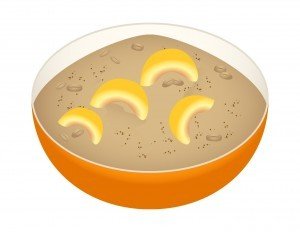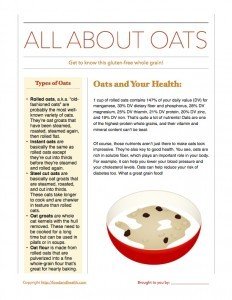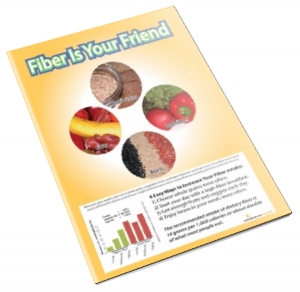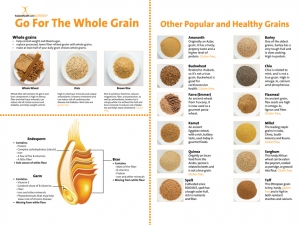What Do You Know About Oats?
 High in vital trace minerals and unique antioxidants, oats can lower cholesterol levels and help you reduce your risk of cardiovascular disease and diabetes. They're also naturally gluten-free! What's not to love?Let's take a closer look at these nutrient powerhouses.1 cup of rolled oats contains 147% of your daily value (DV) for manganese, 33% DV dietary fiber and phosphorus, 28% DV magnesium, 25% DV thiamin, 21% DV protein, 20% DV zinc, and 19% DV iron.* That's quite a lot of nutrients! Oats are one of the highest-protein whole grains, and their vitamin and mineral content can't be beat.Of course, those nutrients aren't just there to make oats look impressive. They're also key to good health. You see, oats are rich in soluble fiber, which plays an important role in your body. For example, according to the study, Oat ingestion reduces systolic and diastolic blood pressure in patients with mild or borderline hypertension: a pilot trial, "The addition of oat cereals to the normal diet of patients with hypertension significantly reduces both [systolic blood pressure] and [diastolic blood pressure]. Soluble fiber-rich whole oats may be an effective dietary therapy in the prevention and adjunct treatment of hypertension." In addition to its blood-pressure-lowering effects, the soluble fiber in oats has documented cholesterol-lowering properties too, specifically in terms of reducing the amount of LDL (a.k.a. "bad") cholesterol in the bloodstream. Since high blood pressure and high cholesterol are significant risk factors for heart disease, heart attack, and stroke, reducing blood pressure and cholesterol are key for good health.
High in vital trace minerals and unique antioxidants, oats can lower cholesterol levels and help you reduce your risk of cardiovascular disease and diabetes. They're also naturally gluten-free! What's not to love?Let's take a closer look at these nutrient powerhouses.1 cup of rolled oats contains 147% of your daily value (DV) for manganese, 33% DV dietary fiber and phosphorus, 28% DV magnesium, 25% DV thiamin, 21% DV protein, 20% DV zinc, and 19% DV iron.* That's quite a lot of nutrients! Oats are one of the highest-protein whole grains, and their vitamin and mineral content can't be beat.Of course, those nutrients aren't just there to make oats look impressive. They're also key to good health. You see, oats are rich in soluble fiber, which plays an important role in your body. For example, according to the study, Oat ingestion reduces systolic and diastolic blood pressure in patients with mild or borderline hypertension: a pilot trial, "The addition of oat cereals to the normal diet of patients with hypertension significantly reduces both [systolic blood pressure] and [diastolic blood pressure]. Soluble fiber-rich whole oats may be an effective dietary therapy in the prevention and adjunct treatment of hypertension." In addition to its blood-pressure-lowering effects, the soluble fiber in oats has documented cholesterol-lowering properties too, specifically in terms of reducing the amount of LDL (a.k.a. "bad") cholesterol in the bloodstream. Since high blood pressure and high cholesterol are significant risk factors for heart disease, heart attack, and stroke, reducing blood pressure and cholesterol are key for good health. In terms of chronic disease, oats can also help lower your risk of diabetes. One study, Effect of Organic Naked Oat With Whole Germ on Type 2 Diabetes Mellitus, explains, "Dietary modification is [...] essential for the prevention and treatment of type 2 diabetes mellitus. Common oat (Avena sativa L.) and its products showed a great potential benefits on NCDs including type 2 diabetes mellitus." Another study, Hypoglycemic effects and biochemical mechanisms of oat products on streptozotocin-induced diabetic mice, asserts, "oat products [have] hypoglycemic effects. Hypoglycemic effects of oat products might be regulating glucose and fat metabolisms, stimulating hormone secretion, activating the nuclear receptor, and protecting organ function." Even if you already have diabetes, oats and oat products can help reduce the health risks and complications associated with it. For example, according to the short-term study Clinical benefit of a short term dietary oatmeal intervention in patients with type 2 diabetes and severe insulin resistance: a pilot study, "hospital admission and diabetes adapted diet followed by oatmeal intervention achieved [an] approximately 40% reduction of insulin dosage required to achieve controlled glucose levels. This effect was conserved after a 4 week outpatient phase with normal diet."By reducing your risk of chronic diseases like heart disease and diabetes, oats can play a role in helping you build a healthy life.Now, where can you get these oats and how can you add them to your eating habits?
In terms of chronic disease, oats can also help lower your risk of diabetes. One study, Effect of Organic Naked Oat With Whole Germ on Type 2 Diabetes Mellitus, explains, "Dietary modification is [...] essential for the prevention and treatment of type 2 diabetes mellitus. Common oat (Avena sativa L.) and its products showed a great potential benefits on NCDs including type 2 diabetes mellitus." Another study, Hypoglycemic effects and biochemical mechanisms of oat products on streptozotocin-induced diabetic mice, asserts, "oat products [have] hypoglycemic effects. Hypoglycemic effects of oat products might be regulating glucose and fat metabolisms, stimulating hormone secretion, activating the nuclear receptor, and protecting organ function." Even if you already have diabetes, oats and oat products can help reduce the health risks and complications associated with it. For example, according to the short-term study Clinical benefit of a short term dietary oatmeal intervention in patients with type 2 diabetes and severe insulin resistance: a pilot study, "hospital admission and diabetes adapted diet followed by oatmeal intervention achieved [an] approximately 40% reduction of insulin dosage required to achieve controlled glucose levels. This effect was conserved after a 4 week outpatient phase with normal diet."By reducing your risk of chronic diseases like heart disease and diabetes, oats can play a role in helping you build a healthy life.Now, where can you get these oats and how can you add them to your eating habits? There are many ways to incorporate oats into your diet. Oats are usually processed into one of the following types...
There are many ways to incorporate oats into your diet. Oats are usually processed into one of the following types...
- Rolled oats, a.k.a. "old-fashioned oats" are probably the most well-known variety of oats. They're the basis for most morning oatmeals and the most popular when it comes to stovetop cooking. Rolled oats are oat groats that have been steamed, roasted, steamed again, then rolled flat. Cook a cup of rolled oats with 2 cups of water until soft and creamy, then top it with spices, fruit, and/or skim milk and you will have a very tasty breakfast.
- Instant oats cook quickly and taste great. They're basically the same as rolled oats except that they are cut into thirds before they're steamed and rolled again.
- Oat groats are whole oat kernels with the hull removed. These need to be cooked for a long time but can be used in pilafs or in soups, just as you would use barley. You can also treat them like oatmeal, cooking up a bowl of groats and topping it with skim milk and fresh or dried fruit.
- Steel cut oats are also known as Scotch oats or Irish oats. They're basically oat groats that are steamed, roasted, and cut into thirds. These oats take longer to cook and are chewier in texture than rolled oats.
- Oat flour is made from rolled oats that are pulverized into a fine, whole-grain flour that's great for hearty baking. Try a little oat flour in your next fruit crisp or batch of oatmeal.
So. Which variety will you try first?A Note About Oats and Gluten: Oats are naturally gluten-free, but there’s a catch. Most oats are contaminated with barley, thanks to the way they’re grown and processed. So, if you're avoiding gluten and you go for oats, be sure to pick up a variety that is certified as gluten-free.And there you have it, a closer look at one of the most nutrient-rich gluten-free whole grains around! What do you think? If you liked the post, don't miss this free handout with fun facts about oats... And, as always, there are more great resources in the Nutrition Education Store!
And, as always, there are more great resources in the Nutrition Education Store!

 *Source: Self Nutrition Data
*Source: Self Nutrition Data


